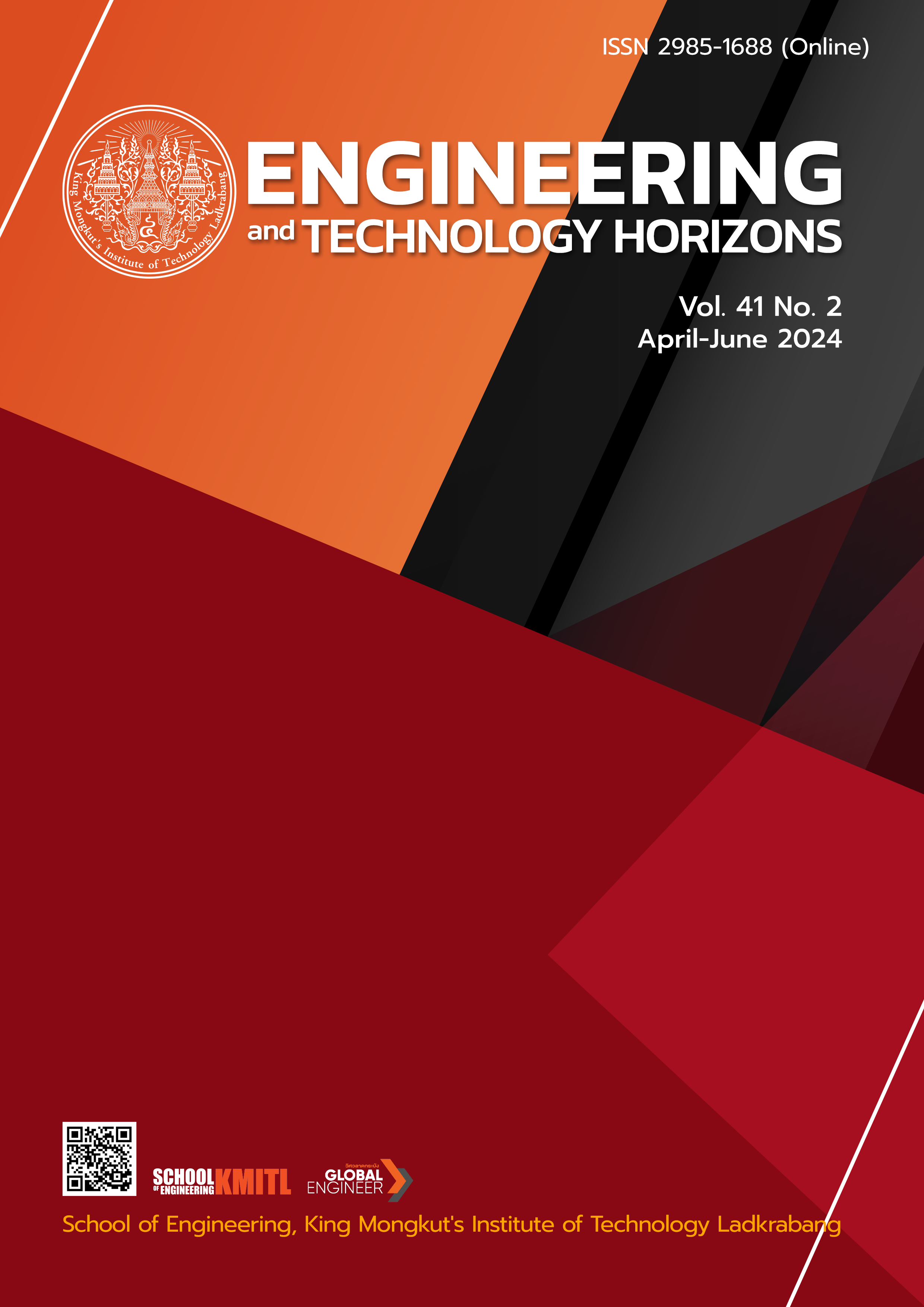การวิเคราะห์และแนวทางการออกแบบสำหรับบริเวณเปลี่ยนผ่านระหว่างสะพานและคันดินในทางรถไฟ
DOI:
https://doi.org/10.55003/ETH.410210คำสำคัญ:
ทางรถไฟ, บริเวณเปลี่ยนผ่าน, วิธีไฟไนต์เอลิเมนต์บทคัดย่อ
งานวิจัยนี้นำเสนอการวิเคราะห์รูปแบบการปรับปรุงเสถียรภาพของบริเวณเปลี่ยนผ่านระหว่างโครงสร้างสะพานและคันดินในทางรถไฟด้วยแบบจำลองวิธีไฟไนต์เอลิเมนต์ (Finite Element Method, FEM) เพื่อเป็นแนวทางในการออกแบบบริเวณดังกล่าว โดยรูปแบบที่ใช้ในการศึกษาทั้ง 3 วิธีนั้นได้รับการแนะนำไว้ในมาตรฐาน International Union of Railways (UIC) 719R ได้แก่ 1. Société Nationale des Chemins de fer Français method (SNCF), 2. Magyar Államvasutak method (MAV) และ 3. Deutsche Bahn method (DB) ในส่วนแรกนั้นปฏิสัมพันธ์ระหว่างรางและสะพานของแบบจำลองได้ทำการสอบเทียบกับกรณี E1-3 จากมาตรฐาน UIC 774-3 ซึ่งผลการวิเคราะห์ให้ผลเฉลยที่ใกล้เคียงกับค่าอ้างอิงจากมาตรฐาน นอกจากนั้นพบว่าการวิเคราะห์โดยคำนึงถึงลำดับก่อนหลังของแรงที่มากระทำจะให้ผลลัพธ์ที่ดีกว่าการรวมกันโดยตรงของผลตอบสนองที่ได้จากแรงแต่ละประเภท จากนั้นทำการศึกษาการปรับปรุงเสถียรภาพบริเวณเปลี่ยนผ่านทั้ง 3 รูปแบบโดยใช้คุณสมบัติของรางรถไฟตามมาตรฐาน UIC 54 และน้ำหนักตามมาตรฐาน U20 ซึ่งเป็นมาตรฐานที่ใช้ในประเทศไทย ผลจากการวิเคราะห์พบว่ารูปแบบทั้ง 3 นั้นสามารถช่วยให้การทรุดตัวบริเวณเปลี่ยนผ่านมีค่าลดลง โดยวิธี DB สามารถลดค่าการทรุดตัวได้มากสุดคิดเป็นร้อยละ 36.18 ส่วนวิธี SNCF และ MAV นั้นมีค่าเท่ากันคือร้อยละ 32.89 อย่างไรก็ตามหากพิจารณาค่าการทรุดตัวร่วมกับเทคนิคในการก่อสร้างจะพบว่าวิธี SNCF นั้นมีความเหมาะสมที่จะใช้เป็นแนวทางสำหรับการออกแบบและการก่อสร้างเพื่อปรับปรุงเสถียรภาพในบริเวณเปลี่ยนผ่าน
References
A. Paixão, E. Fortunato and R. Calçada, “Transition zones to railway bridges: Track measurements and numerical modelling,” Engineering Structures, vol. 80, pp. 435–443, 2014, doi: 10.1016/j.engstruct.2014.09.024.
T. Dahlberg, “Railway track stiffness variations – consequences and countermeasures,” International Journal of Civil Engineering, vol. 8, no. 1, pp. 1–8, 2010.
M. Banimahd, P. K. Woodward, J. Kennedy and G. Medero, “Behaviour of train-track interaction in stiffness transitions,” Proc. of the Institution of Civil Engineers-Transport, vol. 165, no. 3, pp. 205–214, doi: 10.1680/tran.10.00030.
Office of Transport and Traffic Policy and Planning (OTP), Bangkok, Thailand. Manual of design and construction of railway, 2015. Accessed: Nov. 16, 2023 [Online]. Available:https://www.otp.go.th/uploads/tiny_uploads/ProjectOTP/2560/Project06/ManualDesign.pdf.
P. Paoleng, R. Parichatprecha and S. Suthasupradit, “Behavior of Railway Track at Transition Zone and Performance Improvement Techniques: A Review,” Naresuan University Engineering Journal, vol. 13, no. 1, pp. 74–87, 2018. (in Thai)
Earthworks and track-bed layers for railway lines, UIC 719R, International Union of Railways (UIC), Paris, France, 1994.
B. Dareeju, C. Gallage and M. Dhanasekar, “A comparative analysis of the conservative bridge transition design approaches,” in 2014 Proc. Railway Excellence: Rail Transport for Vital Economy, Robert Schweiger, ed., Adelaide, Australia, May 5–7, 2014, pp. 649–657.
C. Esveld, “Track stability and longitudinal forces,” in Modern railway track, 2nd ed. Zaltbommel, Netherlands: MRT productions, 2001, ch. 7, sec. 7.3–7.4, pp. 212–223.
P. Ruge and C. Birk, “Longitudinal forces in continuously welded rails on bridge decks due to nonlinear track–bridge interaction,” Computers & Structures, vol. 85, no. 7–8, pp. 458–475, 2007, doi: 10.1016/j.compstruc.2006.09.008.
R. Sañudo, L. dell'Olio, J.A. Casado, I.A. Carrascal and S. Diego, “Track transitions in railways: A review,” Construction and Building Materials, vol. 112, pp. 140–157, 2016, doi: 10.1016/j.conbuildmat.2016.02.084.
O. C. Zienkiewicz and R. L. Taylor, “Generalization of the finite element concepts. Galerkin-weighted residual and variational approaches,” in The Finite Element Method, Vol. 1: The Basis, 5th ed. Oxford, UK: Butterworth-Heinemann, 2000, ch. 3, sec. 3.2–3.6, pp. 42–60.
W. Kanok-Nukulchai, W. Sommanawat and C. Buachart, “Overview of the finite element method,” Thailand Engineering Journal, vol. 74, no. 3, pp. 58–69, 2021. (in Thai)
J. Real-Herraiz, C. Zamorano-Martin, T. Real-Herraiz and S. Morales-Lvorra, “New Transition Wedge Design Composed by Prefabricated Reinforced Concrete Slabs,” Latin American Journal of Solids and Structures, vol. 13, pp. 1431–1449, 2016, doi: 10.1590/1679-78252556.
H. Wang, VL. Markine, IY. Shevtsov and R. Dollevoet, “Analysis of the dynamic behaviour of a railway track in transition zones with differential settlement,” in Proc. of the 2015 Joint Rail Conference, San Jose, CA, USA, Mar. 2015, pp. 1–7, doi: 10.1115/JRC2015-5735.
Midas Information Technology Co., Ltd., “Midas Civil.” midasoft.com. https://www.midasoft.com/bridge-library/civil/products/midascivil (accessed Jun. 21, 2020).
Track/Bridge Interaction – Recommendations for calculations, UIC 774-3, International Union of Railways (UIC), Paris, France, 2001.
E. Oñate, “Slender plane beams. Euler-Bernoulli theory,” in Structural Analysis with the Finite Element Method. Linear Statics: Volume 2: Beams, Plates and Shells, Barcelona, Spain: International Center for Numerical Methods in Engineering (CIMNE), 2013, ch. 1, sec. 1.3, pp. 6–20.
Midas Information Technology Co., Ltd., “Rail-structure interaction in accordance with UIC774-3.” scribd.com. https://www.scribd.com/document/451407580/Rail-Structure-interaction-midas-analysis-pdf (accessed May 17, 2024).
Midas Information Technology Co., Ltd., “Railway bridge and composite girder bridge analysis.” slideshare.net. https://www.slideshare.net/MidasIT/rail-bridge-and-composite-girder-bridge-analysis (accessed Apr. 20, 2024).
Q. Fu and C. Zheng, “Three-dimensional dynamic analyses of track-embankment-ground system subjected to high-speed train loads,” The Scientific World Journal, vol. 2014, 2014, Art. no.924592, doi: 10.1155/2014/924592.
K. Dong, D. P. Connolly, O. Laghrouche, P. K. Woodward and P. Alves Costa, “The stiffening of soft soils on railway lines,” Transportation Geotechnics, vol. 17, pp. 178–191, 2018, doi: 10.1016/j.trgeo.2018.09.004.
Soil Young’s modulus, geotect data, Sep. 17, 2013, [Online]. Available: https://www.geotesting.org/parameter/soil-young-s-modulus.
Downloads
เผยแพร่แล้ว
How to Cite
ฉบับ
บท
License
Copyright (c) 2024 คณะวิศวกรรมศาสตร์ สถาบันเทคโนโลยีพระจอมเกล้าเจ้าคุณทหาร

This work is licensed under a Creative Commons Attribution-NonCommercial-NoDerivatives 4.0 International License.
บทความที่ได้รับการตีพิมพ์เป็นลิขสิทธิ์ของคณะวิศวกรรมศาสตร์ สถาบันเทคโนโลยีพระจอมเกล้าเจ้าคุณทหารลาดกระบัง
ข้อความที่ปรากฏในบทความแต่ละเรื่องในวารสารวิชาการเล่มนี้เป็นความคิดเห็นส่วนตัวของผู้เขียนแต่ละท่านไม่เกี่ยวข้องกับสถาบันเทคโนโลยีพระจอมเกล้าเจ้าคุณทหารลาดกระบัง และคณาจารย์ท่านอื่นๆในสถาบันฯ แต่อย่างใด ความรับผิดชอบองค์ประกอบทั้งหมดของบทความแต่ละเรื่องเป็นของผู้เขียนแต่ละท่าน หากมีความผิดพลาดใดๆ ผู้เขียนแต่ละท่านจะรับผิดชอบบทความของตนเองแต่ผู้เดียว






